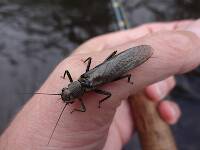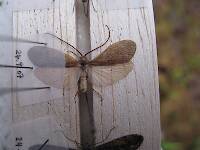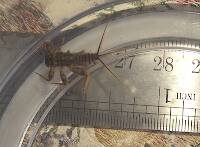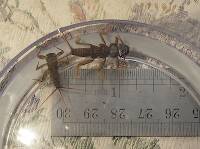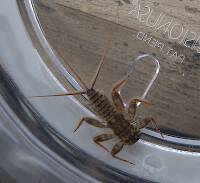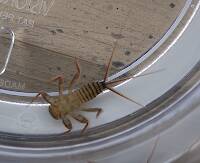
Salmonflies
Pteronarcys californica
The giant Salmonflies of the Western mountains are legendary for their proclivity to elicit consistent dry-fly action and ferocious strikes.
Featured on the forum

Troutnut is a project started in 2003 by salmonid ecologist Jason "Troutnut" Neuswanger to help anglers and
fly tyers unabashedly embrace the entomological side of the sport. Learn more about Troutnut or
support the project for an enhanced experience here.
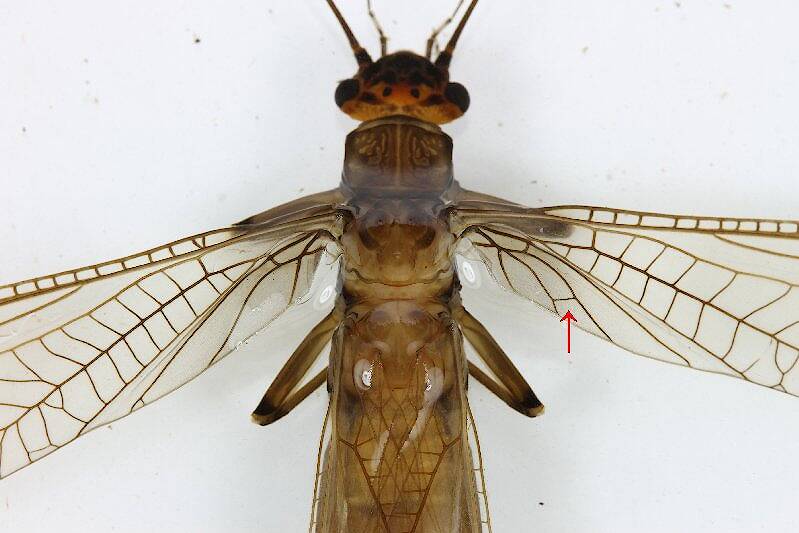
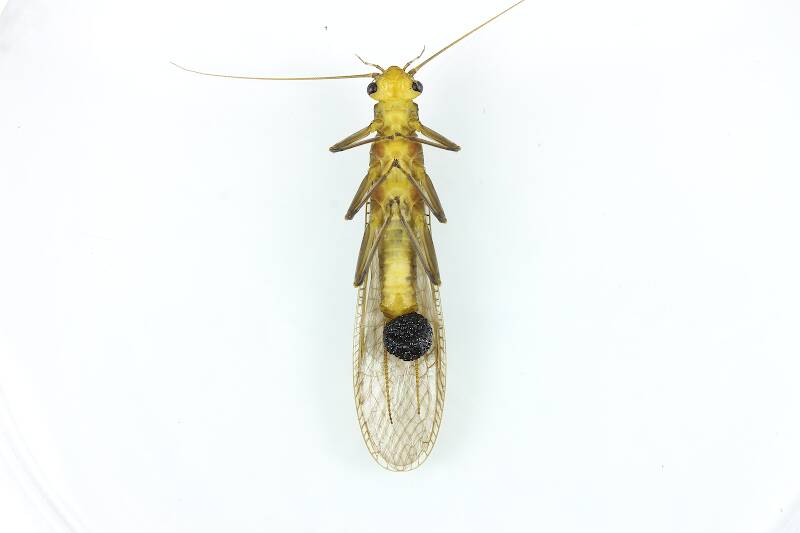
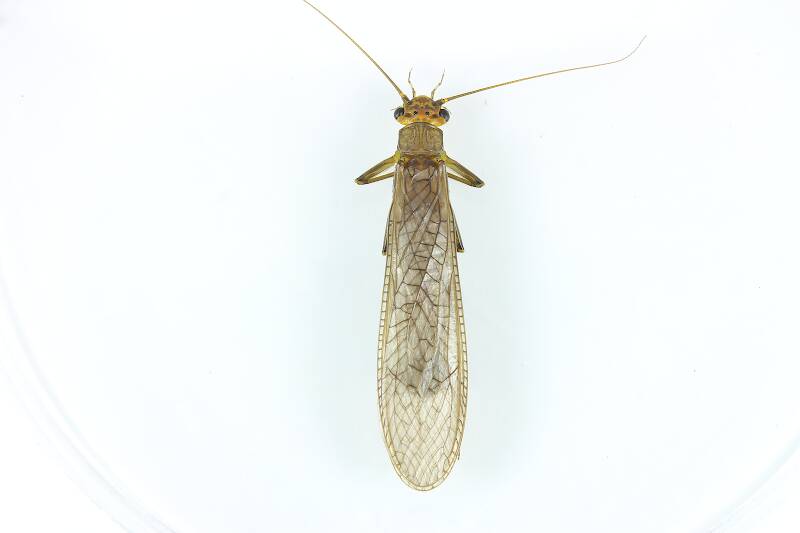
Tsali
Posts: 4
Posts: 4
Tsali on Jun 14, 2015June 14th, 2015, 7:59 pm EDT
Good evening,
I’m working on an identification for a Perlid and something that has me perplexed is the cross vein in the right forewing anal region but doesn’t exist in the left forewing? I’m sure it’s something I’m overlooking. Thanks in advance.
I’m working on an identification for a Perlid and something that has me perplexed is the cross vein in the right forewing anal region but doesn’t exist in the left forewing? I’m sure it’s something I’m overlooking. Thanks in advance.
Taxon on Jun 15, 2015June 15th, 2015, 12:21 am EDT
Gary-
Cross veins are much less consistently located than longitudinal veins. As I recall, Dr. McCafferty shared that information with me well over a decade ago, and in response to a question very similar to yours. :-)
Cross veins are much less consistently located than longitudinal veins. As I recall, Dr. McCafferty shared that information with me well over a decade ago, and in response to a question very similar to yours. :-)
Tsali
Posts: 4
Posts: 4
Tsali on Jun 15, 2015June 15th, 2015, 4:11 am EDT
Thanks for the quick reply. If following Merritt and Cummins would you consider the forewings to have no crossveins then? If with one or more crossveins the couplet takes you to Hansonoperla or Perlinella but the diagnostics for these don't seem to fit.
Thanks.
Thanks.
Feathers5
Posts: 287
Posts: 287
Feathers5 on Jun 15, 2015June 15th, 2015, 5:26 am EDT
That looks like a sulfur to me.
Taxon on Jun 15, 2015June 15th, 2015, 7:25 am EDT
Gary-
I would need some context in order to offer any help regarding genus level identification. In which state or province was this specimen collected, and on what date?
I would need some context in order to offer any help regarding genus level identification. In which state or province was this specimen collected, and on what date?
Tsali
Posts: 4
Posts: 4
Tsali on Jun 15, 2015June 15th, 2015, 4:28 pm EDT
Ignoring the cross vein I keyed this out as Acroneuria but I'm questioning this one for some reason. Body length is 25mm and wing length is 28mm. Specimen was collected in East Tennessee in the Hiwassee River in June. I've attached a couple of dorsal and ventral images to the original post.
Thanks.
Thanks.
Millcreek on Jun 15, 2015June 15th, 2015, 5:53 pm EDT
Gary-
Looks like Acroneuria to me. Here are a couple of sites that show pictures.
http://bugguide.net/node/view/896136/bgimage
http://bugguide.net/node/view/60917/bgimage
Looks like Acroneuria to me. Here are a couple of sites that show pictures.
http://bugguide.net/node/view/896136/bgimage
http://bugguide.net/node/view/60917/bgimage
"If we knew what it was we were doing, it would not be called research, would it?"
-Albert Einstein
-Albert Einstein
Tsali
Posts: 4
Posts: 4
Tsali on Jun 17, 2015June 17th, 2015, 4:44 am EDT
Mark - Thanks for the response.
Roger - Was that enough info? I suppose I should have provided better pics of the key diagnostic parts.
Thanks!
Roger - Was that enough info? I suppose I should have provided better pics of the key diagnostic parts.
Thanks!
Taxon on Jun 17, 2015June 17th, 2015, 8:30 am EDT
Gary-
Sorry for the delay in responding. I also share your and Mark's belief that it's Acroneuria, for which the following species are present in Tennessee:
Acroneuria abnormis (Common Stone)
Acroneuria arida (Elegant Stone)
Acroneuria carolinensis (Carolina Stone)
Acroneuria covelli (no common name)
Acroneuria evoluta (Constricted Stone)
Acroneuria filicis (Illinois Stone)
Acroneuria frisoni (Central Stone)
Acroneuria lycorias (Boreal Stone)
Acroneuria perplexa (Enigmatic Stone)
Acroneuria petersi (Etowah Stone)
Roger - Was that enough info?
Sorry for the delay in responding. I also share your and Mark's belief that it's Acroneuria, for which the following species are present in Tennessee:
Acroneuria abnormis (Common Stone)
Acroneuria arida (Elegant Stone)
Acroneuria carolinensis (Carolina Stone)
Acroneuria covelli (no common name)
Acroneuria evoluta (Constricted Stone)
Acroneuria filicis (Illinois Stone)
Acroneuria frisoni (Central Stone)
Acroneuria lycorias (Boreal Stone)
Acroneuria perplexa (Enigmatic Stone)
Acroneuria petersi (Etowah Stone)
Oldredbarn on Jun 17, 2015June 17th, 2015, 9:50 am EDT
Acroneuria perplexa (Enigmatic Stone)
That is a great name for a bug! "perplexa".
Spence
"Even when my best efforts fail it's a satisfying challenge, and that, after all, is the essence of fly fishing." -Chauncy Lively
"Envy not the man who lives beside the river, but the man the river flows through." Joseph T Heywood
"Envy not the man who lives beside the river, but the man the river flows through." Joseph T Heywood
Quick Reply
Related Discussions
Topic
Replies
Last Reply
Re: Helopicus subvarians (Stonefly) common in New York waters!
In the Stonefly Genus Helopicus by Walleye
In the Stonefly Genus Helopicus by Walleye
6
Jan 9, 2014
by Entoman
by Entoman
9
Jun 19, 2013
by Brookyman
by Brookyman
1
Oct 28, 2008
by GONZO
by GONZO
2
Jul 14, 2008
by Wiflyfisher
by Wiflyfisher
17
Apr 10, 2012
by Entoman
by Entoman
6
Jun 20, 2008
by GONZO
by GONZO





